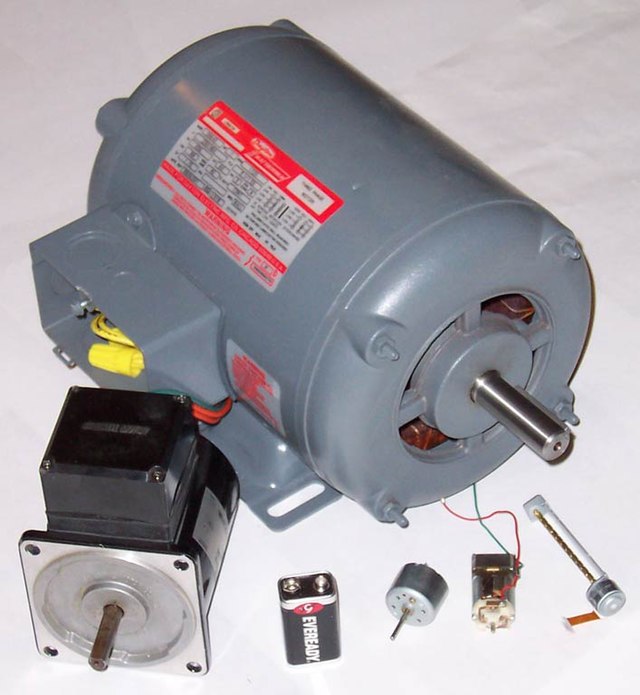Villanymotor
From Wikipedia, the free encyclopedia
Remove ads
A villanymotor olyan villamos gép, amely az elektromágneses indukció elvén az elektromos áram energiáját mechanikus energiává, általában forgó mozgássá alakítja.

Villamos hajtások mozgás-nyomaték viszonyai
A motor tengelyén megjelenő nyomaték és szögsebesség irányától függően négyféle üzemállapot lehetséges. Ezeket a lehetséges állapotokat és a köztük lévő váltásokat a motor villamos és mechanikai tervezésekor figyelembe kell venni. Ennek megfelelően, egy, két, három és négy negyedes hajtásokról beszélhetünk.
Amikor a villanymotor mechanikus energiát állít elő elektromos energia felhasználásával, akkor motorról beszélünk (géptani értelemben „munkagépről”). Ez az I. és III. negyed, amikor a mozgás és nyomaték iránya megegyező. Amikor a villanymotor elektromos energiát állít elő mechanikus energia felhasználásával ("visszatermel" a hálózatra), akkor generátorról beszélünk (géptani értelemben „erőgépről”). Ez a II. és IV. negyed.
Remove ads
Működése
Ha egy mágneses térben elhelyezett tekercsbe elektromos áramot vezetnek, a benne kialakuló mágneses mező kölcsönhatásba lép az állandó mágnesek közötti mágneses mezővel és elfordítja a tekercset (a motor forgórészét).
Története
Az elektromos energia mechanikus energiává való átalakítását Michael Faraday angol tudós mutatta be 1821-ben. Az első valódi egyenáramú motort, ami fő három komponenst tartalmaz (forgórész, állórész és kommutátor), Jedlik Ányos készítette 1828-ban. A gyakorlatban is alkalmazhatóvá pedig Werner Siemens német fizikus tette.
A váltóárammal működő indukciós motor működési elvét az olasz Galileo Ferraris találta fel 1885-ben.[1][2][3][4]
Fajtái
Irodalom
- Shanefield D. J., Industrial Electronics for Engineers, Chemists, and Technicians, William Andrew Publishing, Norwich, NY, 2001.
- Fitzgerald/Kingsley/Kusko (Fitzgerald/Kingsley/Umans in later years), Electric Machinery, classic text for junior and senior electrical engineering students. Originally published in 1952, 6th edition published in 2002.
- Bedford, B. D., Hoft, R. G. et al.. Principles of Inverter Circuits. New York: John Wiley & Sons, Inc. (1964). ISBN 0 471 06134 4 (Inverter circuits are used for variable-frequency motor speed control)
- B. R. Pelly, "Thyristor Phase-Controlled Converters and Cycloconverters: Operation, Control, and Performance" (New York: John Wiley, 1971).
- John N. Chiasson, Modeling and High Performance Control of Electric Machines, Wiley-IEEE Press, New York, 2005, ISBN 0-471-68449-X.
Remove ads
Külső hivatkozások
A Wikimédia Commons tartalmaz Villanymotor témájú médiaállományokat.
Nézd meg a villanymotor címszót a Wikiszótárban!
Magyar nyelven
Egyéb nyelveken
- Electricity museum: early motors
- Electric Motors and Generators, magyarázatok animációkkal az Új-Dél-Walesi Egyetemtől.
- The Numbers Game: A Primer on Single-Phase A.C. Electric Motor Horsepower Ratings, Kevin S. Brady.
- FRACMO Ltd. DC Electric Motor Guide including definitions to common industry terms
- Theory of DC motor speed control
- International Energy Agency (IEA) 4E Annex concerned with Energy Efficiency in Electric Motor Systems
- Interactive Animation of a 3-Phase AC Electric Motor
- Kinematic Models for Design Digital Library (KMODDL) – Videók és fényképek működő mechanikai rendszerek modelljeinek százairól a Cornell Egyetemtől. Tartalmaz egy e-könyvtárat is mechanikai tervezésről szóló klasszikus szövegekkel.
- How Printed Motors work
- Interactive Java Animation: The Rotating Magnetic Field
Remove ads
Jegyzetek
Wikiwand - on
Seamless Wikipedia browsing. On steroids.
Remove ads


